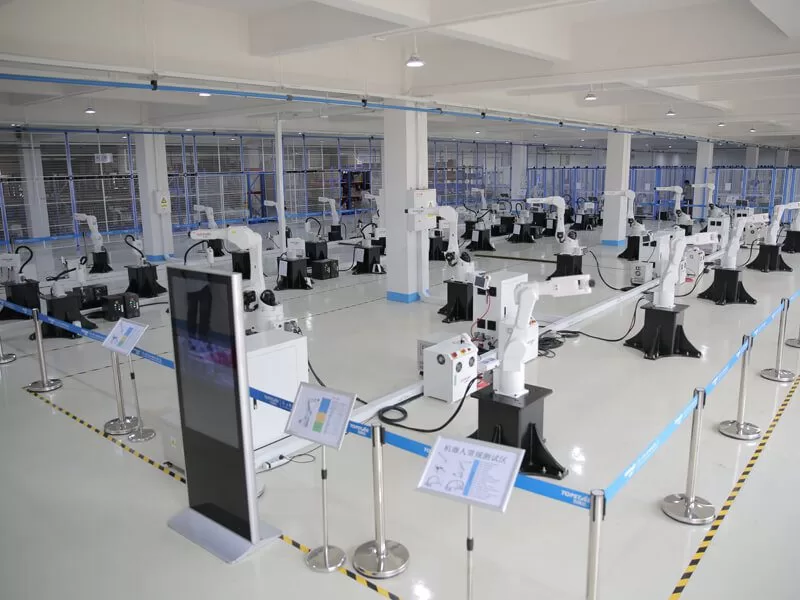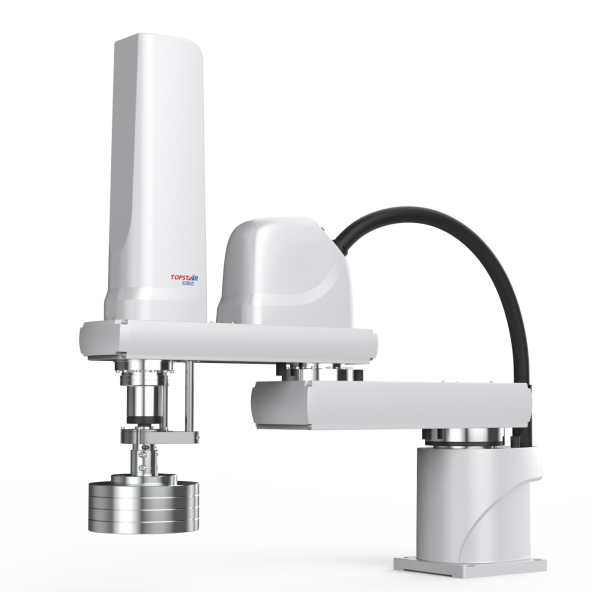Topstar Industrial Robots: Automation Upgrade Driven by Core Technologies
2024/12/16 By Topstar

In the current industrial manufacturing production environment, automation has gradually covered large and small production workshops, and various manufacturing industries are constantly seeking to improve production efficiency and product quality and produce more intelligently. Topstar Industrial Robot has developed three underlying technologies independently and can provide industrial robot solutions supported by core technologies, significantly improving productivity and flexibility. In this article, we will discuss in depth how Topstar’s industrial robots can achieve simple debugging and flexibility with the support of core technologies and can handle more complex work scenarios, making them truly easy to use.
Three underlying technologies of industrial robots
Topstar’s three independently developed underlying technologies: industrial robot control system, high-performance servo driver, and visual algorithm are the keys to achieving automation and intelligence. The open control system can continuously and iteratively enhance the adaptability of the ontology to the process environment. The more energy-saving and highly integrated servo drive provides an accurate and stable guarantee for robot movement. The independently developed vision technology opens up the robot’s perception world, allowing it to sense and identify the surrounding environment and workpieces with high precision. Whether it is positioning, shape detection, or quality inspection, they can accurately obtain and process key information, providing vigorous and more accurate support for subsequent operations.
Implement intelligent scenarios for various applications
Through automation, Topstar industrial robots can perform repetitive and arduous tasks on the production line, improving work efficiency and reducing the risk of manual errors. For manufacturing customers, this means lower maintenance and quality control costs and provides support for customers’ production line automation upgrades.
At the same time, from single-process manual replacement to integrated single-workstations and modular automatic production lines, the realization of various scenarios through “robot+” has dramatically enriched the iteration of industrial robot technology. This flexibility and intelligence allow for seamless scalability, which is suitable for low-volume production and large-scale manufacturing environments. In addition, “Robot+” combines industrial robots with other automation technologies to provide greater customization, ensuring that every aspect of the production line can be automated to meet the unique needs of different applications.

Vision technology for industrial robots
The application of vision technology further strengthens Topstar robots’ role in quality control. Through high-resolution vision systems, industrial robots can detect and identify appearance defects on products, perform rapid identification and precise grasping, and are more able to adapt to changes in different production environments, such as changes in lighting, product orientation, or surface texture. Improving resolution and computing power has irreplaceable advantages for high-precision production, ensuring product consistency and high quality. The benefits of these features go beyond providing the quality of individual products. The accuracy of Topstar robots directly contributes to improved product consistency and uniformity, allowing higher throughput without compromising quality, thereby increasing overall production efficiency.

Realize intelligent communication collaboration
Topstar’s industrial robots realize equipment interconnection through the control system. One workstation can be operated individually, and one central controller can manage multiple workstations. Each workstation has industrial robots that perform different tasks and work together to complete production tasks. A centralized control system can manage the entire operation from a single point, enabling real-time monitoring, coordination, and optimization tasks across multiple workstations. This approach simplifies the complexities of managing various robots and ensures operations run smoothly and efficiently.
Additionally, intelligent collaboration between robots ensures optimal resource allocation. When production conditions change, the system can automatically redistribute tasks and adjust the overall production plan. This efficient communication enables distributed control, allowing intelligent group power to function in flexible scenarios with small orders and multiple categories.
Iterative upgrades to meet different production needs
Topstar’s open underlying architecture and system design allow industrial robots to adapt to different production needs and enable easy reprogramming and configuration for various tasks and operations. This flexibility and ease of use can improve the efficiency of production line upgrades and reduce the difficulty of adapting to growing production capacity requirements.
In the 3C field, some companies have introduced Topstar six-axis robots for optimization and production line upgrades in processes such as shell laser engraving and overall auxiliary material lamination. They have been deployed in single stations and entire production lines. According to actual calculations, UPH (output per unit hour) increased by 20% after use, and the stability of the product was also greatly improved. At the same time, these companies’ industrial robots have optimized their processes by applying workstation technology, achieving a three-step upgrade from equipment intelligence to production line automation and management informatization.
Optimize production for enterprises
Industrial robots are not only performers but also data collectors and analysts. They can collect large amounts of data in real-time, such as production speed, quality indicators, and fault reports. This data helps companies make intelligent decisions, optimize production processes, and predict maintenance needs, improving efficiency and reducing costs.
TRENDING POSTS
- What factors can cause delays in the injection molding process of plastic molding machine? 2024/12/16
- Exhibition Review| Topstar participates in InterPlas Thailand 2024 2024/12/16
- Star Case | Topstar helps Santong upgrade its intelligent plant 2024/12/16
- Topstar Special | National Science and Technology Workers Day 2024/12/16
HOT TOPIC
- 3 in 1 Compact Dehumidifying Dryer
- 5-axis CNC machine
- accuracy
- Air Chillers
- all electric injection molding machine
- all electric injection molding machines
- All-electric injection molding machines
- and overall production quality. Therefore
- AP-RubberPlas
- automated injection molding machine
- Automation changed engineering
- automation of injection molding robots
- auxiliary machine
- Bench Injection Molding Machine
- Cabinet dryer manufacturers
- Cabinet dryers
- chiller
- CNC Drilling Machine
- CNC Drilling Machines
- cnc engraving machine manufacturer
- cnc laser cutting machine manufacturer
- CNC machine
- CNC Machine Center
- CNC Machine for Sale
- CNC Machine Manufacturing
- CNC Machine Tool
- CNC machine tool product
- CNC Machining Center
- CNC wood carving machine
- Cooling system
- Cross-Walking Single Axis Servo Cylinder Robot
- Cross-Walking Single-Axis Servo Cylinder Robot
- Cross-Walking Three-Axis/Five-Axis Servo Driven Robot
- cross-walking three-axis/five-axis servo-driven robot
- Dehumidifier Dryer
- Dehumidifying Dryer
- delta parallel robot
- Desktop Injection Molding Machine
- Desktop injection molding machines
- Desktop Molding Machine
- desktop plastic injection machine
- Desktop Plastic Injection Molding Machine
- direct clamp injection molding machine
- Direct clamp injection molding machines
- Dosing & mixing system
- Drilling Centers
- Drying and dehumidification system
- drying and dehumidifying equipment
- Drying and Dehumidifying System
- drying system
- effective and efficient. Cabinet dryers are also used in other industries where large quantities of material need to be dried
- efficient injection molding machine
- elbow hydraulic injection molding machines
- electric injection molding machine
- electric injection molding machines
- energy-saving injection molding machine
- etc. Among injection molding robots
- exhibition
- features of CNC machine
- Feeding And Conveying System
- Five Axis Machine Center
- Fully automatic injection molding machine
- Gathering Topstar
- giant injection molding machine
- GMU-600 5-Axis Machining Center
- Granulating & Recycling System
- Heavy duty injection molding machine
- Honeycomb rotor dehumidifier
- horizontal injection molding machine
- Horizontal Injection Molding Machines
- Horizontal Injection Moulding Machine
- Horizontal Mixer manufacturer
- How The CNC Machine Works
- hybrid injection molding machine
- hydraulic injection molding machine
- Hydraulic Injection Molding Machines
- in this article
- Industrial robot
- Industrial Robot Chinese brand
- industrial robot parts
- industrial robot supplier
- Industrial robots
- Industry Chain
- Injection Manipulator
- injection mold machines
- Injection molding
- Injection molding automation
- Injection Molding Automation Solution
- injection molding dryer
- Injection molding equipment
- injection molding hopper dryer
- Injection molding machine
- injection molding machine brand
- Injection Molding Machine Factory
- Injection Molding Machine Manufacture
- Injection molding machine manufacturer
- injection molding machine manufacturers
- Injection molding machine procurement
- injection molding machine robotic arm
- injection molding machine with a robot
- Injection molding machines
- injection molding material dehumidifying
- injection molding plant
- Injection Molding Robot
- injection molding robot arm
- Injection molding robot automation
- Injection molding robotic arm
- injection molding robots
- Injection Moulding Robots
- Injection Robot
- Injection robot arm
- Injection robot manufacturer
- Injection robot wholesale
- injection robots
- intelligent injection molding machines
- Introducing Injection Robot
- It is the best choice for drying large quantities of material at once. Cabinetmakers use these machines because they are fast
- large injection molding machine
- Learn what industrial automation and robotics is
- low speed sound-proof granulator
- machine plastic molding
- make sure to add some! Improvements (2) Keyphrase in introduction: Your keyphrase or its synonyms appear in the first paragraph of the copy
- manipulator machine
- manufacturing
- micro injection molding machine
- middle speed granulator
- Mini CNC machine manufacturers.
- Mold Temperature Control System
- mold temperature controller
- molding material Dehumidifying System
- mould temperature controller
- mould temperature controllers
- New electric injection molding machine
- nitrogen dryer manufacturer
- nitrogen dryer system manufacturer
- Oil type mold temperature controller
- open day
- Outbound links: No outbound links appear in this page. Add some! Images: No images appear on this page. Add some! Internal links: No internal links appear in this page
- PET Preform injection molding
- phone case maker machine
- phone case making machine
- plastic bottle making machine
- plastic bottle manufacturing
- plastic bucket making machine
- plastic bucket manufacturing
- Plastic chair making machine
- plastic forming equipment
- plastic hopper dryer
- plastic injection machine
- plastic injection machines
- plastic injection molding
- Plastic injection molding equipment
- Plastic injection molding machine
- Plastic Injection Molding Machines
- plastic injection robot
- Plastic Molding machine
- Plastic Molding Machines
- plastic molding press
- plastic phone case making machine
- plastic-molding machine
- powerful granulator
- Powerful Type Sound-Proof Granulator
- production of plastic seats
- Robot injection molding
- robot injection molding machine
- robot manufacturing companies
- Robotic arm for injection molding machine
- robotic injection molding machines
- robotics in injection molding
- SCARA robot
- SCARA robots
- Service-oriented manufacturing
- Servo Cylinder Robot
- servo driven robot
- Servo Driven Robots
- servo injection robots
- Servo-Driven Robot
- Setup of injection machine
- Silicone Injection Molding Machine
- six-axis industrial robot
- Stainless Hopper Dryer
- Stainless Hopper Dryers
- star club
- swing arm robot
- the choice between servo-driven robots and hydraulic robots will have a certain impact on efficiency
- the most popular injection molding machine
- the type of injection molding robot
- toggle clamp injection molding machine
- Toggle Hydraulic Injection Molding Machines
- toggle injection molding machine
- Top 10 brands of injection robots
- Topstar
- Topstar Engineering
- Topstar Industrial Robots
- Topstar injection molding intelligent
- Topstar Scara Robots
- Useful Injection molding machine
- Vertical machining centers
- volumetric type blender
- water chiller
- water chillers
- water distributor
- Water Type MoldTemperature Controller
- We often face choices when performing injection molding. We will choose the type of injection molding machine
- wholesale of injection molding machines
- x carve CNC
